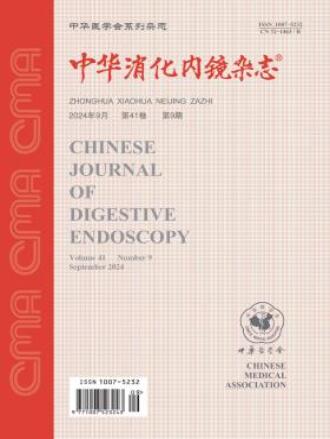Billroth II型胃切除术后影响壶腹部ERCP通路的因素
引用次数: 0
摘要
目的探讨BillrothⅡ胃切除术患者内镜逆行胰胆管造影(ERCP)进入壶腹的影响因素。方法回顾性分析2008年1月至2017年12月在长海医院行ERCP的261例BillrothⅡ胃切除术患者资料。采用多因素logistic回归分析影响壶腹通路成功的潜在因素,采用受试者工作特征(ROC)曲线评价潜在因素的预测能力。结果共收集ERCP 345次。壶腹插管成功率为82.3%(284/345),插管成功率为89.1%(253/284)。ERCP手术失败的主要原因是无法到达十二指肠盲端和找到乳头(66.3%,61/92)和选择性插管失败(33.7%,31/92)。ercp相关并发症发生率为14.2% (49/345),ercp后胰腺炎发生率为3.2%(11/345)。多因素logistic回归分析显示首次ERCP尝试(OR=7.717, 95%CI: 2.581-23.068)。P<0.001)、Braun吻合(OR=8.737, 95%CI: 2.479 ~ 30.797, P=0.001)和无帽辅助前视胃镜(OR=2.774, 95%CI: 1.283 ~ 5.997, P=0.009)是壶腹吻合失败的独立危险因素。根据logistic回归分析中各危险因素的B值,即无cap辅助为1分,第一次ERCP尝试为2分,Braun吻合为2分,ROC曲线下面积为0.773。分界点为2.5时,敏感性为75.0%,特异性为70.8%。结论首次ERCP尝试、Braun吻合、无帽辅助前视胃镜是BillrothⅡ胃切除术患者壶腹ERCP入路失败的危险因素。早期识别高危患者有助于提高壶腹入路成功率。关键词:胆管造影;内镜逆行;胃切除术,BillrothⅡ;风险因素本文章由计算机程序翻译,如有差异,请以英文原文为准。
Factors affecting ampullary access of ERCP after Billroth II gastrectomy
Objective
To investigate factors affecting ampullary access of endoscopic retrograde cholangiopancreatography (ERCP) in patients undergoing Billroth Ⅱ gastrectomy.
Methods
A retrospective analysis was performed on data of 261 patients with Billroth Ⅱ gastrectomy who underwent ERCP at Changhai Hospital from January 2008 to December 2017. Multivariate logistic regression analysis was used to analyze the potential factors affecting successful ampullary access, and receiver operating characteristic (ROC) curve was used to assess the predictive ability of potential factors.
Results
A total of 345 ERCP sessions were collected. The successful ampullary access and cannulation rate were 82.3% (284/345) and 89.1% (253/284), respectively. The main reasons for ERCP procedural failure were unable to reach the duodenal blind end and find the papilla (66.3%, 61/92) and failure of selective cannulation (33.7%, 31/92). The ERCP-related complication rate was 14.2% (49/345), with post-ERCP pancreatitis rate was 3.2% (11/345). Multivariate logistic regression analysis indicated that the first ERCP attempt (OR=7.717, 95%CI: 2.581-23.068. P<0.001), with Braun anastomosis (OR=8.737, 95%CI: 2.479-30.797, P=0.001), and no cap-assisted forward-viewing gastroscope (OR=2.774, 95%CI: 1.283-5.997, P=0.009) were independent risk factors for failure of ampullary access. According to the B value of each risk factor in logistic regression analysis, that is, no cap-assisted as 1 point, the first ERCP attempt as 2 points, and Braun anastomosis as 2 points, the area under ROC curve was 0.773. When the cut-off point was 2.5, the sensitivity and specificity were 75.0% and 70.8%, respectively.
Conclusion
The first ERCP attempt, with Braun anastomosis, and no cap-assisted forward-viewing gastroscope are risk factors for failure of ampullary access of ERCP in Billroth Ⅱ gastrectomy patients. Early identification of high-risk patients may help to improve the success rate of ampullary access.
Key words:
Cholangiopancreatography, endoscopic retrograde; Gastrectomy, Billroth Ⅱ; Risk factors
求助全文
通过发布文献求助,成功后即可免费获取论文全文。
去求助
来源期刊
CiteScore
0.10
自引率
0.00%
发文量
7555
期刊介绍:
Chinese Journal of Digestive Endoscopy is a high-level medical academic journal specializing in digestive endoscopy, which was renamed Chinese Journal of Digestive Endoscopy in August 1996 from Endoscopy.
Chinese Journal of Digestive Endoscopy mainly reports the leading scientific research results of esophagoscopy, gastroscopy, duodenoscopy, choledochoscopy, laparoscopy, colorectoscopy, small enteroscopy, sigmoidoscopy, etc. and the progress of their equipments and technologies at home and abroad, as well as the clinical diagnosis and treatment experience.
The main columns are: treatises, abstracts of treatises, clinical reports, technical exchanges, special case reports and endoscopic complications.
The target readers are digestive system diseases and digestive endoscopy workers who are engaged in medical treatment, teaching and scientific research.
Chinese Journal of Digestive Endoscopy has been indexed by ISTIC, PKU, CSAD, WPRIM.

 求助内容:
求助内容: 应助结果提醒方式:
应助结果提醒方式:


